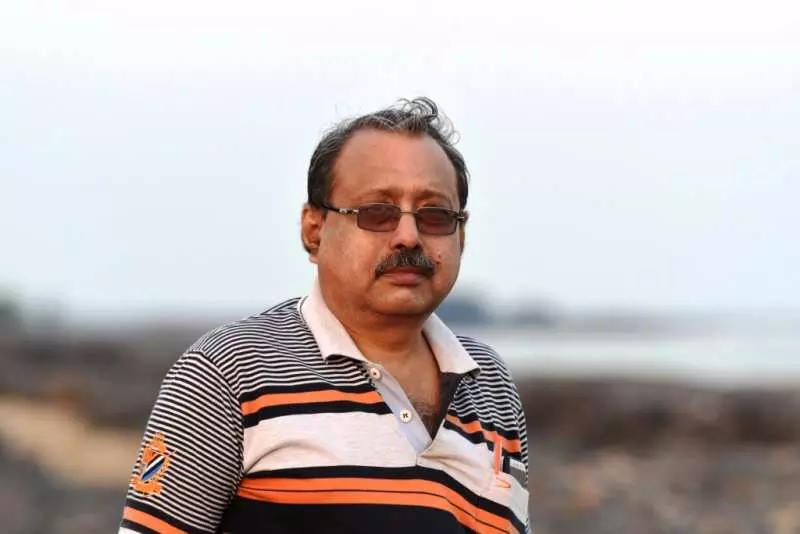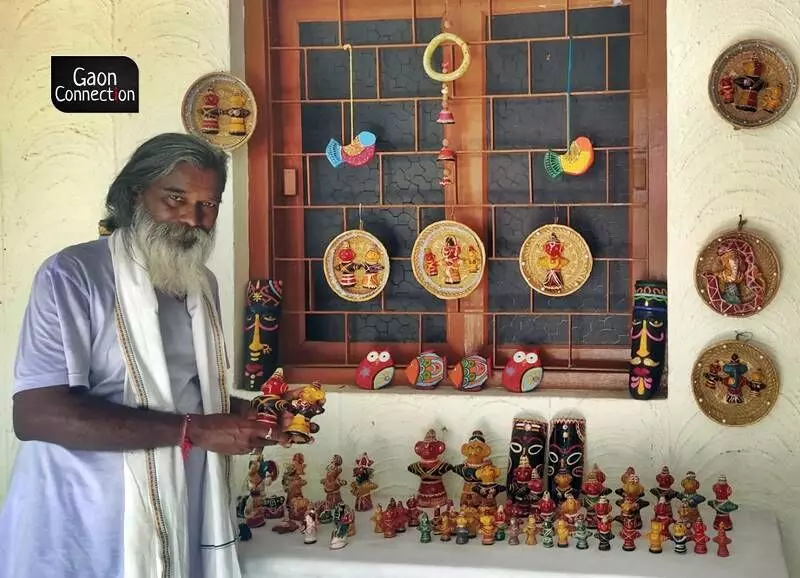The Jaukandhei lac doll-making tradition of Odisha sees a revival
Jaukandhei is a traditional folk art from Odisha that represents the state's culture, literature, art, religion and spirituality. The Jaukandhei dolls are usually in pairs with a male and a female, and are considered to be auspicious symbols of conjugal happiness.
 Ashis Senapati 8 Sep 2022 1:39 PM GMT
Ashis Senapati 8 Sep 2022 1:39 PM GMT

Over the years, due to the advent of plastic and machine-manufactured processes, the Jaukandhei tradition faltered. All photos by Kesu Das
Kanakalata Das carefully added the finishing touches to a figurine she held in her hands and set it down with the line of other finished ones waiting on the side. Along with her were a few other women who applied brightly coloured lac to figurines that are called Jaukandhei (meaning lac dolls).
This is a traditional folk art from Odisha, and the dolls that Kanakalata and the other women were making are called Baleswari Jaukandhei, because they are made in Balasore. The figures are made of clay, then they are fired and finished off with bright and shiny lacquer paint.
Kanakalata heads a self-help group in Koshamba Nagar village, on the outskirts of Balasore town in Odisha.
"We formed the Binapani SHG with 15 women in 2005 and ever since we have been making lac figurines of different sizes," the 48-year-old, told Gaon Connection.
The Jaukandhei dolls are usually in pairs with a male and a female, and are considered to be auspicious symbols of conjugal happiness.
Lac dolls, bangles and boxes are made and used in households in this area for generations.
Also Read: The Dongria Kondh tribal women weave an income out of their traditional shawls
"In many villages, ceremonial weddings are organised for the dolls and they are also an integral part of festivals such as Sabitri Brata. Women worship Lakshmi and Narayan, and offer them lac dolls as they seek prosperity and a happy marriage," Kesu Das, a craftsman and artist who is from Koshamba Nagar and has worked tirelessly to revive the languishing craft, told Gaon Connection.
The 58-year-old Kesu Das did his Masters in fine arts from the Mahatma Gandhi Kashi Vidyapith in Varanasi, and returned to Balasore and set up the Baleswari Kala Kendra in Balasore, a cultural centre where folk art and crafts are studied, taught and revived.
Traditional lac dolls
"Jaukandhei represents our culture, literature, art, religion and spirituality," Basudev Das, researcher and member of the Odisha Sahitya Academy, Bhubaneswar, told Gaon Connection. "Since time immemorial newlywed women carry the lac dolls and deities to their husbands' home after their marriage," he added.
The lac work is a laborious process. Lac, a minor forest produce, is the resinous secretion of lac insects found on trees. The hard resinous substance is collected, crushed and sieved before it is processed into a form that is used on the Jaukandhei dolls.
Also Read: Dhokra craft brings back smiles on the faces of artisans in Odisha's tribal heartland
Lac dolls, bangles and boxes are made and used in households in this area for generations, said Priya Ranjan Kar, secretary of Odisha Silip Mahasangha. "Women gather together and in their leisure time create these beautiful pieces," he said.
According to the craftsman Kesu Das, "A lac doll can cost anything from Rs 30 to Rs 3,000. And, an artisan earns anything between Rs 10,000 and Rs 30,000 per month from this craft."
The sector is gradually recovering as almost 50 per cent of the craft-persons are now back in their work.
The artisans purchase lac from the market paying Rs 1200 per kilogram. It takes the craftsperson abut an hour to make one doll, and if it is a big one about two hours. On an average each artisan can make upto 10 figurines a day.
Over the years, due to the advent of plastic and machine-manufactured processes, the Jaukandhei tradition faltered. "The demand for plastic items in the 1970s inflicted a huge loss to the lac doll makers. But, since the notion of eco-friendliness has emerged, lac is again in high demand," Priya Ranjan Kar, secretary of Odisha Silip Mahasangha, Jajpur, told Gaon Connection.
The COVID-19 pandemic caused a setback to the craft. "The impact was severe as many doll makers stopped their work. Many of the craftspeople were forced to move away from their traditional craft work and look for work elsewhere in order to make ends meet," Maya Nayak, a 52-year-old maker from Arada Bazaar, told Gaon Connection. "But now the situation is getting better since the government has allowed craft melas and festivals to take place," she added.
Also Read: Tribal farmers in Mayurbhanj earn an annual profit of Rs 1 lakh an acre by cultivating rubber
Revival of Jaukandhei
"The sector is gradually recovering as almost 50 per cent of the craft-persons are now back in their work. We hope the lac dolls items will sell in healthy numbers," Basumati Behera, a 38-year-old craftsperson from Tartari village, told Gaon Connection.
In 2021, the Handloom, Textiles & Handicrafts Department started a project in Balasore district to offer training and an added income to women. "At present, we are training around 50 women. Our department is also helping lac doll makers market their craft in melas that are also being organised by our department," Arun Mandal, assistant director of the Handloom, Textiles & Handicrafts Department, Balasore, told Gaon Connection.
The training programmes are conducted by master craftspeople who teach them the intricacies of making the figurines and working with lac. The trainings are conducted usually in the villages of the women, and the workshops/training can be up to six months duration.
Also Read: 'Nuakhai' — Odisha's harvest festival that celebrates the reaping of paddy
According to Kesu Das, "Not just the 50 women, the revival of crafts fairs and the advent of the festive season, has brought relief to around 200 doll makers in Koshamba Nagar, Nalamganj, Arad Bazaar, Bampada, Kain Gadia, Tartari and other villages of Balasore district."
"Craft fairs are back and stronger than ever with artists and visitors flocking to the fairs. We are happy to see that the sales are strong, and the market is back on its feet," craftsperson Padmini Das, from Nalamganj village, told Gaon Connection.
The festive season has galvanised the craftspeople into action, but they are not complaining. Bhanumati Sahoo a lac doll maker from Bampada village hoped to make a lot of profit in this season. "We have been spending sleepless nights since the last few days making hundreds of lac dolls of different sizes to sell in the craft melas and festivals," she told Gaon Connection, happily.
#Odisha #Handicraft
More Stories




